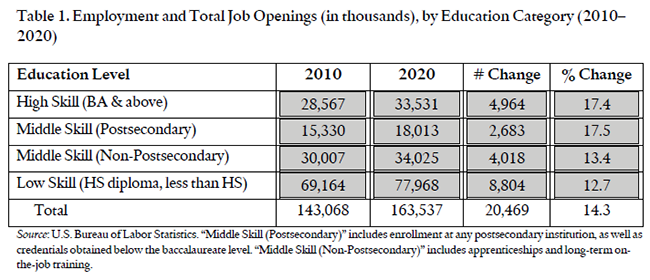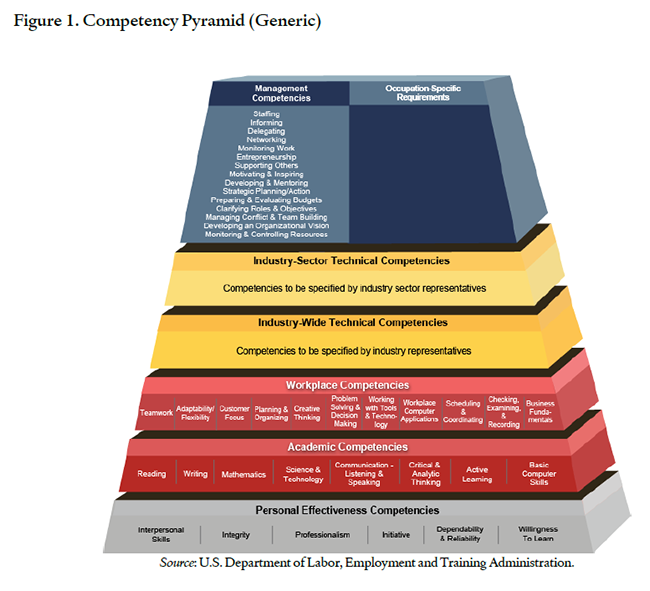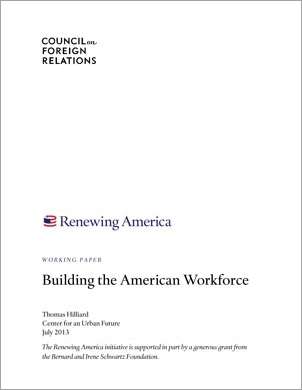This report was published by Council on Foreign Relations and is reprinted with permission.
Click here to download the full report as a PDF.
There has never been greater urgency for expanding and improving U.S. workforce training programs. Even before the onset of the Great Recession, an alarming number of Americans lacked the skills and education credentials needed to compete for decent-paying jobs in an economy transformed by globalization and accelerating technological change. In the Great Recession’s wake, new jobs capable of supporting a family will increasingly require more than a high school diploma.
Journalists and policymakers have focused predominantly on the quantity and quality of jobs being created in the U.S. economy. They should also pay attention to the difficulty of training people to qualify for those jobs. Employers claim they cannot find job candidates with appropriate vocational training, work-related soft skills, or aptitude in reading, writing, and math. Such skills have always been expected in the high-skill occupations reserved for holders of bachelor’s and advanced degrees. But to an unprecedented extent, employers now need and expect applicants with “middle skills” qualifications—a level of education and training beyond a high school diploma, but less than a bachelor’s degree. The supply of middle-skilled jobseekers lags behind.
Policymakers can narrow this skills gap and prepare the workforce of tomorrow by overhauling the national workforce-development system. Workforce providers do not serve enough of the disadvantaged, low-skilled population that needs services and would provide a high-yield return on investment. They are also not adequately engaging with employers to ensure their workforce services are the ones that employers genuinely need, too often emphasizing inadequate short-term services over better longer-term training toward market-recognized credentials. Finally, the workforce field has grown increasingly fragmented as major programs harden within silos and goals are set without regard for any larger vision.
Employers and disadvantaged workers desperately need a high-functioning workforce system. Now is the right time to build it. The most important changes cost little, but prepare the ground to spend taxpayer dollars much more effectively. The federal government should begin by: establishing a broad and integrative vision across workforce, postsecondary, adult education, and social-services programs; developing performance measures that align across multiple systems; and rewarding providers for helping disadvantaged clients hit milestones toward self-sufficiency. This integrated system should be supported by data warehouses at the federal or state level to connect educational and workforce services with data on employment outcomes. The overhauled system should be funded at a level large enough to bolster regional labor markets.
With a common vision and a careful division of responsibility between all the stakeholders in building human capital, the United States could secure its long-term competitiveness and prosperity in a dynamic global economy.
Labor Market Transforms, Workforce Stays Behind
When news broke in the fall of 2012 that New York City’s poverty rate rose to nearly 21 percent, the highest point in more than a decade, a spokesperson for Mayor Michael Bloomberg pointed to a surprising culprit: the growing skills gap. “These poverty numbers reflect a national challenge: the U.S. economy has shifted and too many people are getting left behind without the skills they need to compete and succeed.”
Indeed, the combination of globalization and technological advances has transformed the economy in recent years. One result is that the skills demanded by employers in virtually every industry have risen dramatically. But the skills of the country’s workforce have lagged behind.
GLOBAL LABOR MARKET MOVING FAST
Once upon a time, breakthroughs in technology disrupted the established order. Today, technological change is the established order. The accelerating pace of discovery and application shapes the kinds of jobs Americans can do, and raises the qualifications needed to obtain and keep those jobs. Tasks that can be reduced to a set of rules will be shifted to the least expensive workplace setting. By coding the task, an employer can shift it to a computer (e.g., tax preparation), a robot (e.g., warehouse order fulfillment and battery production), or overseas (e.g., smartphone production and customer service).
The effect of the technological revolution has been profound. Where legal secretaries once typed up and laboriously formatted court briefs, specialized software conducts those tasks automatically, enabling law firms to shrink their administrative staffing. Where travelers once purchased airplane tickets from travel agents and airline personnel, they now go online. Shoes once made on a cobbler’s bench and later manufactured on an assembly line are now produced, distributed, and increasingly sold without ever being held by a human hand.
At the same time, the globalization of the U.S. economy has opened up the U.S. labor market to international competition, especially in the tradable goods and services sector. Companies have greater capacity than ever before to move their worksites to locations with the lowest labor costs, and to build complex equipment by linking supply chains from multiple countries. Competitive pressure on employers to reduce labor costs and develop flexible production processes has grown more intense.
Still, many occupations, particularly in the nontradable service sector, cannot be outsourced abroad or replaced by technology. An actual person needs to perform high-touch tasks like sweeping floors, caring for disabled seniors, or making burritos. But such occupations have few entry requirements. The supply of workers who apply for them greatly exceeds the demand, resulting in low wages and unstable working conditions.
Occupations that employers reward with higher wages and benefits require skills in thinking and communicating that cannot be reduced to a code. These include occupations like auto mechanics who once learned how to fix cars by watching other mechanics fix them. Today, computerized diagnostic systems locate a car’s problems, but the mechanic must be able to identify which diagnostic tests to use and how to interpret the findings. A salesperson must explain why one microprocessor design works better than another, and take a customized order requiring informed and probing questions.
The twin forces of globalization and technology have eliminated whole occupations whose tasks can be carried out more cheaply by computers or foreign workers. Between 1980 and 2010, employment doubled in high-skill occupations that require expert thinking and complex communications, such as engineers, managers, and scientists. Meanwhile, occupations vulnerable to automation or outsourcing, such as administrative support, rose only slightly.
Manufacturing was hit hardest. Over the past half-century, hundreds of American factories closed, and the remaining plants survived through automation. After World War II, manufacturing accounted for 25 percent of all U.S. employment, but by 2009 the share had fallen to 11 percent. The decline accelerated after 1980. In that year, machine operators accounted for 10 percent of the U.S. workforce; by 2010, they accounted for only 4 percent.
As flexibility and adaptability have become essential to competitive companies, they have transferred the risks associated with a volatile consumer market to their workforce. The result has been soaring growth of the contingent workforce—workers whose job tenure is temporary, and who in most cases are employed by a staffing firm rather than the employer using their services. In 1999, employers used an estimated 990,000 contingent workers nationwide. By 2007, the number of contingent workers had grown to three million. The Bureau of Labor Statistics estimates that by 2018 the contingent workforce will expand to six million. These contingent workers are not, for the most part, choosing a more flexible work life, but simply taking employment where they can find it.
KNOWLEDGE ECONOMY AND MIDDLE-SKILLS GAP
The workers who have weathered the storm the best have postsecondary degrees. Over the past decade, adults with some college or an associate’s degree have consistently earned about 20 percent more than adults with only a high school diploma, while adults with a bachelor’s degree earned roughly twice as much. Since the 2007–2009 recession, the number of jobs requiring a high school diploma or less has fallen by 10 percent, while jobs requiring some college or an associate’s degree held steady, and the number of jobs requiring a bachelor’s degree or better rose by 5 percent.
But although economic success depends on postsecondary education, that education need not take the form of a traditional four-year bachelor’s degree. Workers can receive an income boost from completing an apprenticeship or on-the-job training program, as well as earning a vocational certificate, industry certification, or associate’s degree. More than twenty-nine million jobs requiring middle-skill education or training pay more than $35,000 annually. One in four workers with licenses and certificates earns more than the average employee with a bachelor’s degree, as do three in ten workers with an associate’s degree. Some certificates are even more rewarding than bachelor’s degrees for people who work in their field of study. An adult with an aviation certificate, for example, can earn $65,000, and some computer/IT certificates offer $70,000 in annual earnings.
Jobs in this middle-skill segment of the American labor market are projected to grow more rapidly than lower-skill jobs over the next decade. About 38 percent of the labor market, or forty-five million adults, held middle-skill jobs in 2010. The Bureau of Labor Statistics forecasts that occupations requiring a postsecondary credential will grow about five percentage points faster than those that do not. Middle-skill postsecondary employment is expected to rise by 17.5 percent from 2010 to 2020—about the same rate as high-skill employment (see Table 1). Meanwhile, middle-skill employment requiring apprenticeships and job training is expected to grow by about 13.4 percent, which is faster than low-skilled job growth.

Yet employers are struggling to fill middle-skill jobs with qualified candidates, despite the weak economy inherited from the recent recession. Employers report again and again that they face a chronic gap in the skills needed for job openings compared to those possessed by job applicants. In 2010, at a time when the nation’s unemployment rate was still well over 8 percent and millions of Americans had been jobless for more than a year, more than half of American employers reported difficulty filling positions because of a lack of suitable skills. In another national survey, more than half of employers (53 percent) said their company faces a major challenge in recruiting non-managerial employees with the needed skills, training, and education. Two-thirds of manufacturing firms, according to a Manufacturing Institute survey, have either a moderate or severe shortage of qualified workers; almost half of the surveyed companies reported a severe shortage of production workers, which remains an important occupation for middle-skilled adults.
The middle-skills gap damages job creation and economic mobility. Employers are less likely to create good jobs with long-term advancement potential if the productivity of their workers does not cover their higher wages. A recent McKinsey study found that 86 percent of U.S. employers surveyed would pay more for a job candidate with the right training and hands-on experience—more than any of the other eight countries surveyed. In the absence of those skilled candidates, employers will compete on the basis of lower costs, a path that leads to outsourcing and widespread use of part-time and temporary workers.
Disadvantaged and displaced adults are the ones hit hardest by the middle-skills gap. Disadvantaged adults often live in high-poverty or distressed areas, and struggle with chronic unemployment, fewer job opportunities, and low pay. These adults may have been poorly served by the formal education system, and in many cases dropped out of high school or graduated with poor literacy and numeracy skills.
Displaced adults have lost their jobs, in most cases because of the labor-market trends described above. Many have worked for a single employer for more than ten years, and their current skills set may not be suited to a change in industry or occupation. Even as unemployment in the general population shrinks, the number of long-term unemployed continues to grow. The population of long-term unemployed adults as a share of all unemployed adults is now higher than at any point since the Great Depression. Almost four out of ten jobseekers have been looking for work for at least six months. Some economists argue that many of these adults remain unemployed because they lack the qualifications required for new job openings. But the problem is not simply an overall lack of skills, since many of the long-term jobless actually possess higher skills than competitors who are quickly rehired, but the decay of their skills and the lack of direct contact with employers.
These disadvantaged and displaced workers need something different from the traditional post-secondary experience: four years on a college campus, ivied walls, and grassy quads. They need education that moves more quickly and engages directly with employers. This is where middle-skill attainment and the workforce system intersect.
TRAINING THE WORKFORCE
The middle-skills gap refers not to one specific kind of skill set, but several that are interrelated. Hiring managers want a broad and varied spectrum of skills, which they do not always clearly articulate to jobseekers. These skills start with vocational skills specific to the occupation or sector, include basic literacy, numeracy, computer familiarity, and soft skills like punctuality and interpersonal communication, and extend to high-end workplace skills like problem-solving, team management, and creative thinking.
One useful way of visualizing the dilemma faced by employers and jobseekers is the competency pyramid, a model devised by the U.S. Department of Labor’s Employment and Training Administration (see Figure 1). The model is available for twenty-one separate industries, and the pyramid for each industry is designed by industry leaders, not government officials. The competency pyramid depicts skills needed by all or most jobseekers at the base, moving up to industry-wide vocational skills and then skills needed in specific sectors of the industry, finally reaching management competencies at the summit.

Looking at the bottom half of the pyramid reveals why so many adults never achieve stable careers. The first layer consists of personal competencies such as dependability, integrity, and willingness to learn. The second, academic competencies, comprises the basic skills taught in school (e.g., reading, math, computer proficiency, and communications). The third layer pertains to higher-order soft skills, including teamwork, planning and organizing, working with technology, and creative thinking. The subject of most traditional workforce policy, technical competencies, only emerges in the fourth layer.
The skills deficits in those first three layers are enormously frustrating to U.S. employers. According to the 2003 National Assessment of Adult Literacy, 14 percent of American adults read at “below basic” literacy level, and another 29 percent read and write at only a basic prose level. This shortfall in the basic tasks of reading, writing, and carrying out simple arithmetic may be the largest factor holding back disadvantaged youth and adults. For example, a survey of human resource professionals conducted by the Society for Human Resource Management found that young people entering the labor market lacked important skills possessed by older workers preparing to retire: most notably, writing in English (51 percent) and professionalism/work ethic (52 percent).
Disadvantaged jobseekers may not know how to scale the base of the competency pyramid and reach the point where they can obtain the technical competencies and credentials that put them on a solid career track. Displaced jobseekers, on the other hand, have developed skills appropriate to their old workplace that may be unsuited for a new career—not only vocationally, but also in terms of basic and soft skills. For example, workers laid off from manufacturing who enter healthcare must navigate a different work culture, with an ethic of teamwork and customer service at odds with the traditional factory floor.
The informational deficit that employers face in this environment has damaging consequences for the labor market. Hiring managers seek middle-skill candidates with specific occupational or professional credentials, which are easily signaled (although not necessarily up to date). But other skills, such as literacy, computer proficiency, work ethic, and collaborative spirit are more difficult to identify, even in a job interview. In the absence of widely accepted credentials, applicants have every incentive to claim relevant basic, personal, and workplace skills, since their viability as prospective employees depends on it. Employers have responded with a variety of counterproductive workarounds: using software programs that screen out candidates because of formatting mistakes in their resumes, hiring applicants with bachelor’s degrees even when the job does not require it, poaching employees from other companies rather than hiring unemployed adults, or filling positions with temporary workers who can be easily dropped at the first sign of inadequacy. Developing workforce strategies to train adults effectively for open positions and demonstrate their value to employers would be a far more effective alternative.
The workforce development field can assist jobseekers in navigating their way up the competency pyramid, and assist employers by reducing guesswork in the hiring process and fostering long-term employment relationships. In the twenty-first century economy, there are few win-win opportunities. But workforce development, done properly, is one of them.




